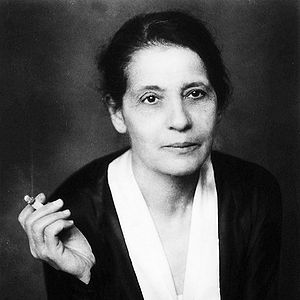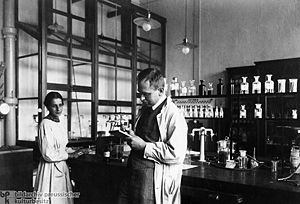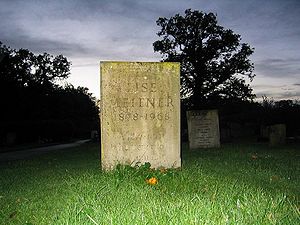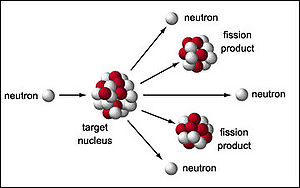Lise Meitner
Created and in Progress by Olivia Pool, PHYS 2211, Section N06

Lise Meitner (1878-1968) was an Austrian physicist known for her work in radioactivity and nuclear fission.
Personal Life
Early Life
Lise Meitner was born in Vienna, Austria, on November 7, 1878, as the third of eight children. Her father was a lawyer from Moravia and strongly supported equal education for his sons and his daughters. Her mother's family had emigrated from Russia to Slovakia. Although they were Jews, the Meitners did not practice their religion, and most of the Meitner children converted to Catholicism. After showing early excellence in mathematics, Lise Meitner received private tutoring, and her passion for learning continued to grow.
Life in Academia
In 1901, Meitner entered the University of Vienna, studying physics under Ludwig Boltzmann. After becoming the second woman to receive a PhD in Physics from the University of Vienna in 1906, she moved to Berlin to study with Max Planck, a physicist. For nearly seven years, Meitner worked as Planck's unpaid Physics Department assistant and published work on radioactive properties. It was very uncommon for women to be working in the lab at this time, however Meitner's program allowed her to collaborate with chemists in addition to other physicists. At this time, she met Otto Hahn, a chemist she would collaborate with for over 30 years. In 1922, Meitner became a university lecturer while also continuing her research on radioactive properties.

Even though she became a Protestant in 1908, Meitner forced to leave Germany in 1938 and head to Sweden due to her Jewish heritage and the rise of Adolf Hitler. In Sweden she worked at Manne Siegbahn's institute in Stockholm, but due to Siegbahn's prejudice again women in science, she received very little support. Hahn and Meitner were able to meet secretly in Sweden to continue their experiments. Their research was published in 1939 and provided evidence for nuclear fission, a discovery ultimately led to the Manhattan Project and the creation of the atomic bomb.
In 1944, Hahn was awarded the Nobel Peace Prize for Chemistry because of the research, but Meitner was overlooked. Meitner was awarded the Enrico Fermi Award along with Hahn in 1966. However, the Nobel mistake was never acknowledged.
In 1960, Meitner retired to Cambridge, England, before passing away on October 27, 1968.

Scientific Contributions
Nuclear Fission
Meitner's experiments with Hahn provided evidence for nuclear fission and led to the creation of the atomic bomb.
In 1934, a scientist by the name of Enrico Fermi discovered that he could produce radioactive isotopes by neutron bombardment using uranium. This inspired Meitner and Hahn to continue experiments with uranium alongside their assistant, Fritz Strassman. After further tests on uranium, they believed they created radium as a product, but it was soon discovered to be barium.
Confused by the results, Meitner and Strassman took a walk in the woods to clear their minds, and soon discovered that the nucleus of the uranium atom was splitting. With the help of her nephew, Otto Frisch, Meitner used Bohr's "liquid drop" model of the nucleus as a basis for her calculations to confirm the splitting of the uranium nucleus. Meitner and Hahn named the process "nuclear fission."

By the end of 1939, Meitner and Hahn's research had spread across America. In 1944, Albert Einstein used Meitner and Hahn's research to write a letter to President Franklin D. Roosevelt about the danger of atomic weapons. Meitner was recognized by President Harry Truman in 1945 at a dinner for the Women's Press Club and was also congratulated by Eleanor Roosevelt for being a strong woman in science. Meitner and Hahn's research was extremely important for the Manhattan project, in which the United States created an atomic bomb to drop on Japan and end World War II. Meitner became known as the "mother of the atomic bomb."
Realizing the power of her work, Meitner soon began to oppose the use of nuclear fission in the creation of weapons. Although she understood the importance of her work, she did not support the amount of destruction atomic weapons cause. Her gravestone reads "Lise Meitner: a physicist who never lost her humanity."
Other Information
Fun Facts
- Three of Meitner's sisters went on to earn PhD degrees, most likely due to their father's strong support of equal education for men and women.
- In her first year of working with Otto Hahn, the pair had to work in a remodeled carpenter's shop because women were not officially allowed in the lab at the University of Berlin. At many labs they worked in, Meitner had to be registered as a guest under Hahn, even though everyone knew they were considered equal in the lab.
- In 1918, Meitner discovered the element protactinium with Otto Hahn.
- In 1992, element 109 was named Meitnerium in Lise Meitner's honor.
Connectedness
- How is this topic connected to something that you are interested in?
- How is it connected to your major?
- Is there an interesting industrial application?